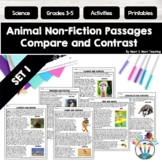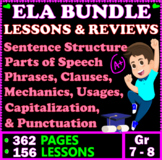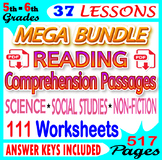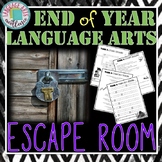191 results
8th grade chemistry centers for Microsoft Word
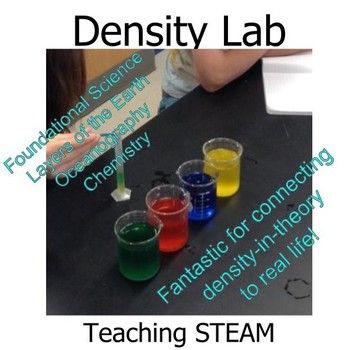
Density Lab
This lab is fantastic for connecting density-in-theory to real life! This winner is great for general science, layers of the earth, oceanography, marine biology, or chemistry. My students are always so proud of themselves for figuring it out! The student sheet includes a section on evaluating the model (vital to the Next Gen. Science Standards!) Fits very well in a science journal/interactive students notebook (ISN). The teacher instructions gives detailed material list, instruction, and hints f
Subjects:
Grades:
7th - 10th
Types:
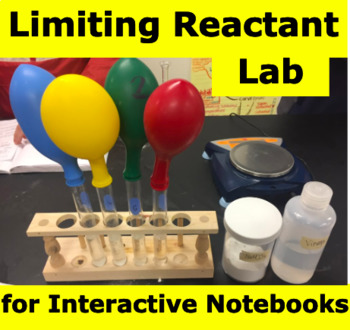
Limiting Reactant Lab (vinegar & baking soda)
This lab usually takes about 45 minutes including the post-lab calculations. You will need vinegar, baking soda, test tubes and balloons. The handout is formatted so it can be folded like a book and glued in students notebooks. I've done this with my "on-level" 10th grade chemistry class for several years and it works well.Follow me on Twitter @DenmanChem to see more from my chemistry class.
Subjects:
Grades:
8th - 12th
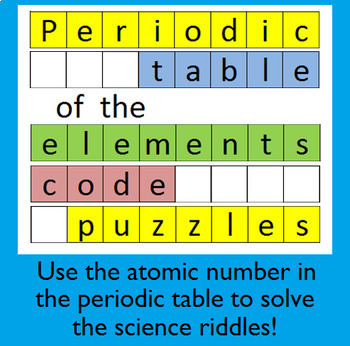
Periodic Table of the Elements Code Puzzle
Use the period table of the elements to find the atomic number in each box. Then write the symbol for that element to solve the riddles below. This activity helps students practice using the periodic table, and lets them have fun at the same time! My students loved being "Codebreakers", and this activity made them much more fluent when using the periodic table of the elements. See if they can create their own "code" when they've finished. There are 10 different puzzles to complete, so you can us
Subjects:
Grades:
8th - 11th
Types:

Endothermic vs. Exothermic Reaction Lab
In this lab, students explore the difference between an endothermic and exothermic reaction through by combining hydrogen peroxide & yeast (part 1) and baking soda & vinegar (part 2). This is a great lab to show the differences in the release and absorption of heat. Includes all steps of the scientific method, along with a full rubric for assessment.
Subjects:
Grades:
6th - 9th
Types:
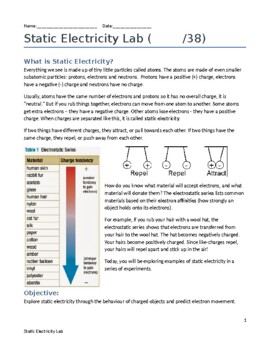
Static Electricity Lab
Students will visit 5 different stations to explore static electricity in this lab. This file is editable to your needs, and stations can be removed based on what materials or equipment you have. Students find this lab very engaging and enjoy seeing static at work!Students will investigate the three types of static charge (friction, contact, and induction), and practice using the electrostatic series to determine final charges of objects.Materials (flexible based on which stations used):● balloo
Subjects:
Grades:
7th - 12th
Types:
Also included in: High School Lab Bundle
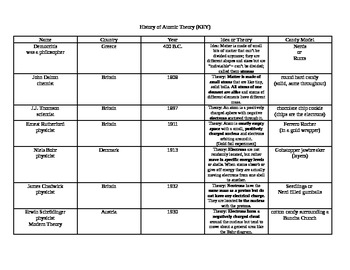
Candy Models of History of Atomic Theory
docx. file Use candy as model to help students remember the history of Atomic Theory. Includes completed chart, modified fill in the blank type chart, and a blank chart with only headings. Students can find information in a textbook or on the internet.
Subjects:
Grades:
7th - 10th
Types:
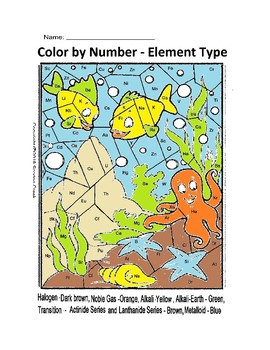
Fish Chemistry Color By Number - Metal, Non-Metal, Transition etc
Here is a fun way to explore the element type as well as feed their artistic side. The element types include metalloid, non-metal, Metal, Halogen, Noble gas, Alkali etc. It should take about 25 minutes or to 30 minutes.
Subjects:
Grades:
7th - 12th
Types:
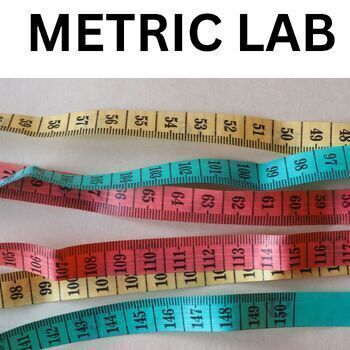
Metric System (SI) Measuring Fun Activity Middle, High School Science
Grade 8 STEMThis resource was created to help teachers review and teach the Metric system and density. It is a classic lab highly recommended for the start of the school year. Students will be engaged and learn how to use the Metric SystemThis product contains1. Fun no prep lab2. 10 Metric problems3. Answer KeyMATERIALSRuler10 index cardsBalanceGraduate cylinderRubber stopperWaterThe metric system is a decimal system based on the meter, liter, and gram as units of length, capacity, and wei
Subjects:
Grades:
7th - 9th
Types:
Also included in: Metric and Measuring labs
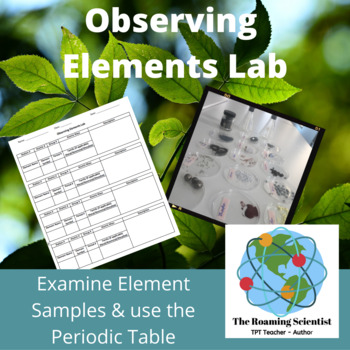
Observing Elements Lab
This lab can be used in a unit about the Periodic Table or as a review for students as they begin to study more advanced chemistry. The fully editable lab sheet can be used to focus on a variety of properties of both elements and the Periodic Table: how to find information on the table including group number, period number, atomic number, atomic mass and classification of elements (metal, non-metal, metalloid) as well as the family (halogen, alkali metal, transition metal etc.). It can also be u
Subjects:
Grades:
6th - 10th
Types:
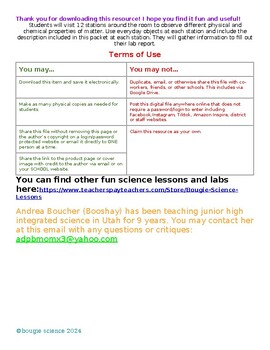
Observing Properties of Matter Scavenger Hunt
Students visit 12 lab stations around the room to observe various physical and chemical properties of matter and see how they can be useful for jobs in society.
Subjects:
Grades:
8th - 10th
Types:
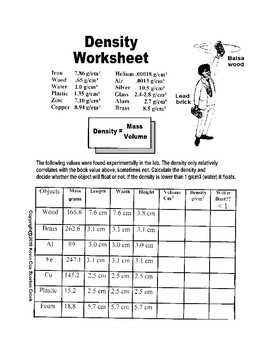
Density Worksheet
For those that want to do a lab. Here is a quick worksheet for you to do. For those that don't have time to do the density lab, this is the raw data of those that have done the lab in my classroom. Like all labs, the results generally match the accepted values. The students practice using the density formula to calculate its value. They then decide if it would float in water (density less than 1 gm/cm3). The generally accepted values of this substances are given but like most actual labs results
Subjects:
Grades:
5th - 12th
Types:

Ooblek Lab
This is a short lab to show the Law of Conservation of Mass. Students will measure corn starch and water and measure the masses. Although a fun new substance is made the mass will stay the same. There is a page with data table included and another copy where students must complete their own data table.
Subjects:
Grades:
5th - 9th
Types:
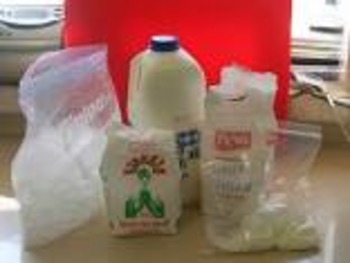
Ice Cream Making, Yummy - Laboratory Experiment
This laboratory experiment is sure to become a student favorite, as they use their chemistry knowledge of the colligative property, freezing point depression, to prepare ice cream that they get to eat! While they conduct the experiment, they will review several concepts pertaining to solutions: solvent and solute; saturated, unsaturated, and supersaturated solutions; dilute and concentrated solutions; the four colligative properties; data collection; and some general laboratory techniques. Stu
Subjects:
Grades:
7th - 11th
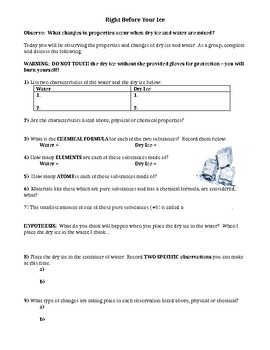
Properties and Changes of Dry Ice and Water Lab
This lab is a comprehensive review of the basic chemistry of dry ice and water including their formulas, elements and number of atoms included as well as the concepts of compounds, changes to matter and the Law of Conservation of Matter/Mass. Students make observations to the materials and changes to the dry ice and water while they combine the two and classify the changes to the matter and its properties. Adding soap to the mixture as well as food coloring extends this activity to help identi
Subjects:
Grades:
8th - 11th
Types:
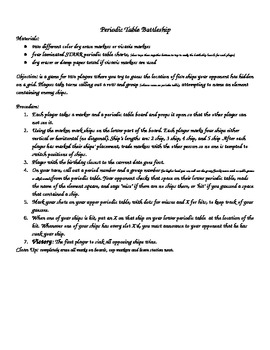
Periodic Table Battleship
This is a great way to get kids to practice using the words period and group while getting acquainted with the periodic table. At a higher level you can have them practice the family names such as Noble gases or Alkali metals instead of Group numbers.
Another hint for memory is to write the words in their notes this way:
G
R
O
U
PERIOD
so they can have a visual reminder of which one goes up and down and which one goes side to side
Subjects:
Grades:
5th - 10th
Types:
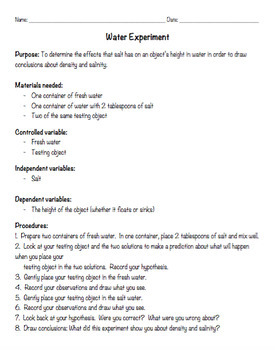
Salinity and Density of Water Experiment
Students will work through this water experiment in order to test objects in fresh water and salt water to determine the reactions (whether it floats or sinks, time it takes for it to sink, how far it sinks, etc.). This experiment organizer will help students organize their hypothesis, observations, and conclusions.Terms of Use:The content of this purchase may be used for personal and classroom use only. This license is not intended for use by multiple users, including within school districts,
Subjects:
Grades:
1st - 8th
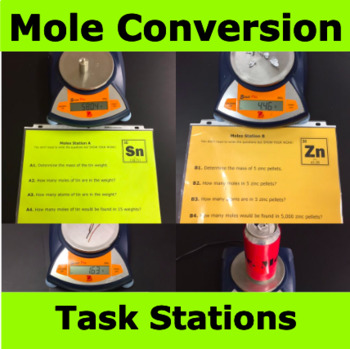
Mole Conversion Task Stations (one & two step, elements & compounds)
This Mole Conversion Task Stations features 10 stations. 5 stations are single element, one step problems and 5 stations are compounds with one & two step problems. Students will find the mass of the object, then complete the mole conversion questions. I use the first 5 on the second day of the moles unit and the second 5 later in the unit.Material suggested (this is editable, so you can swap out for what you have)tin weightzinc pelletscopper wirealuminum cancharcoal briquettechalkwatersugar
Subjects:
Grades:
8th - 12th
Types:
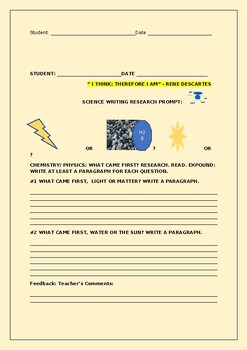
CHEMISTRY/PHYSICS:WRITING RESEARCH PROMPT: GRS. 8-12/MG
This is a research prompt with a set of 2 questions to research and ponder. Students respond about the origin of what came first! There is a space on the prompt page for feedback from the teacher. Uses this for a center activity, homework assignment, or as a science activity in an open computer lab slot.Thank so much for visiting and supporting our shop. Knowledge is power!
Subjects:
Grades:
8th - 12th, Higher Education, Adult Education, Staff
Types:
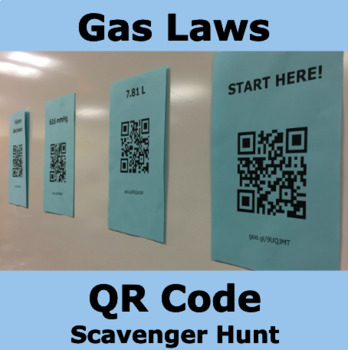
Gas Laws QR Code Scavenger Hunt
This QR code scavenger hunt features questions about Boyle's Law, Charles's Law, Gay-Lussac's Law, Dalton's Law and the Ideal Gas Law. · 15 total questions · 6 calculations · 5 recall the equations · 3 determine the relationships (if pressure increases what happens to volume)This fun activity gets students out of their seat. It could be used as a review or as an assignment right after teaching the different gas law equations. I've used this in my "on-level" 10th grade chemistry classes for year
Subjects:
Grades:
8th - 12th
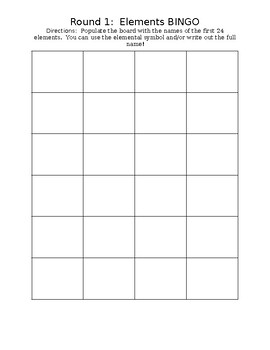
Get to Know the Elements! Bingo to practice element recognition for beginners
How is it that K represents potassium and Na represents sodium? Instead of discussing the origins of the symbols, this activity allows students a fun way to practice identifying the elements. The game is set-up to practice identifying the first 24 elements, but can easily be altered to practice elements found in different groups or periods. Students will randomly write the elements in their bingo board and then attempt to earn a bingo (be sure to choose the correct winning bingo type prior to
Subjects:
Grades:
6th - 9th
Types:
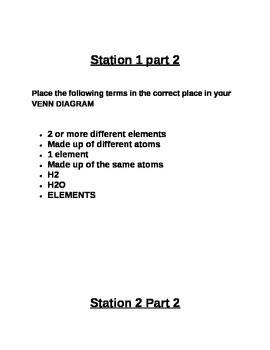
Stations for Elements, Compounds, Organic vs Inorganic and Energy
There are 4 stations for this review station lab. The more sets of stations you print out the smaller your groups can be. Students will rotate around the stations every 5-8 minutes depending on students readiness level over the concept. Students will use the Student answer document (listed free in my store) to answer the questions on the table. This is student centered and the role of the teacher is to guide them in the right direction for rotations and to answer misconceptions. Students will vi
Subjects:
Grades:
5th - 12th
Types:
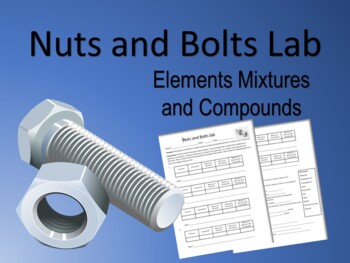
Elements, Mixtures, Compounds Lab
This lab is a GREAT way for students to visualize elements, mixtures, and compounds. Students will investigate a few numbered dishes, each that has a specific combination of nuts, bolts, and washers assembled or not assembled to represent chemical bonds. Students then investigate the contents of the dish, and determine if the dish best represents an element, mixture, compound, or mixture of compounds, or mixture of compounds and elements. The end of the activity has a great follow up with though
Subjects:
Grades:
5th - 11th
Types:

Separating Mixtures Lab
In this chemistry lab, students will review the classification of matter as pure substances and mixtures. They will design their own method for separating a heterogeneous mixture back into its individual components.You will need:- 100 mL of mixture (sand, water (H2O), iron (Fe) flakes, Styrofoam, and salt (NaCl))- 100 mL beaker- hot plate- magnet- 1 funnel- 1 coffee filter*If you do not have iron flakes, staples will also work!This lab is fully editable and is very simple to set up.check out my
Subjects:
Grades:
7th - 10th
Types:
Also included in: High School Lab Bundle
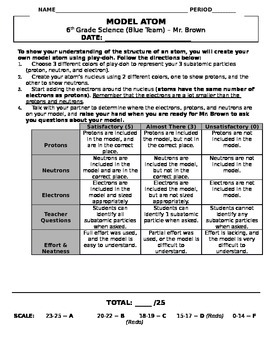
Play-Doh Model Atom
In this assignment, students use play-doh to create a model atom. They need to include the correct number of each subatomic particle, and relative size of each particle is included as well. A full rubric is included for assessment. This was a huge hit with my 6th grade classes.
Subjects:
Grades:
6th - 9th
Types:
Showing 1-24 of 191 results




